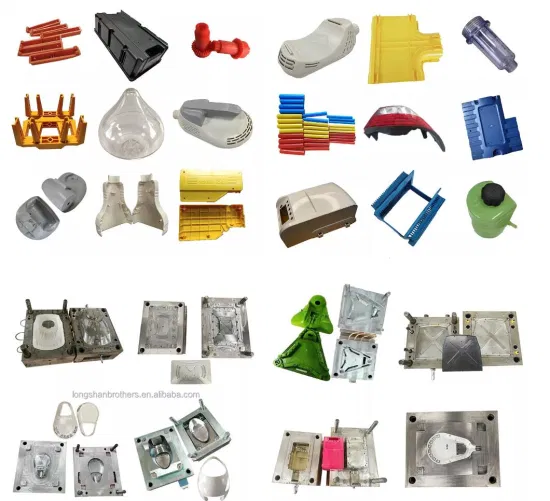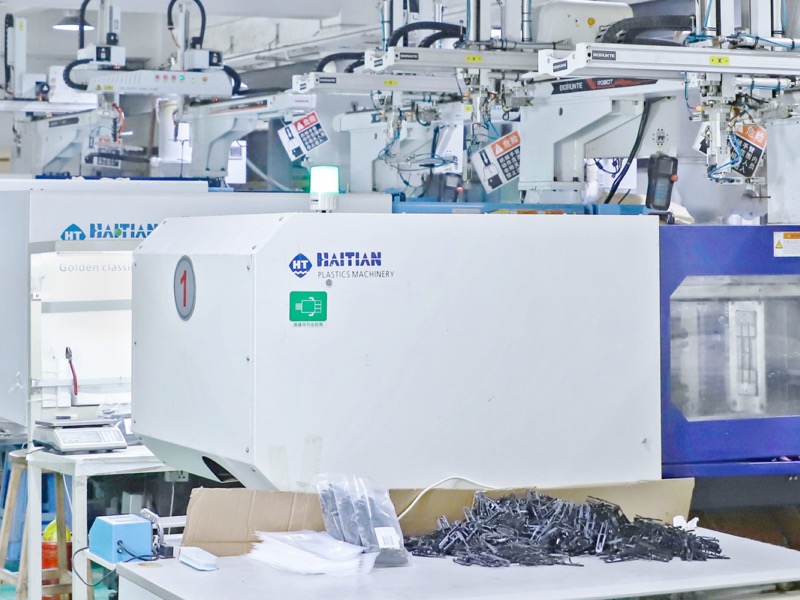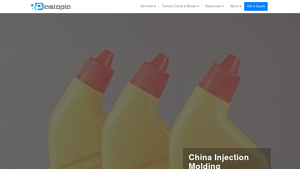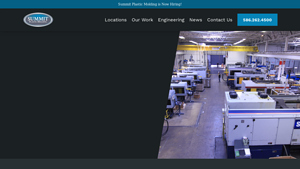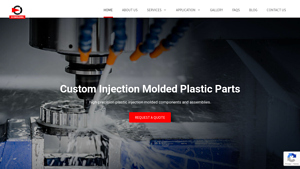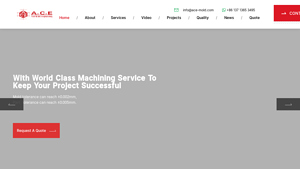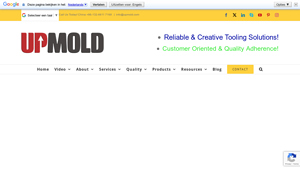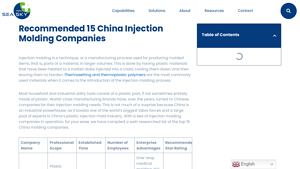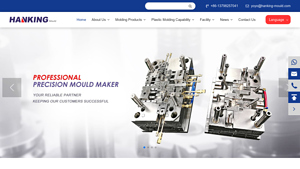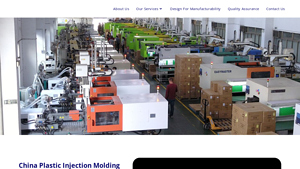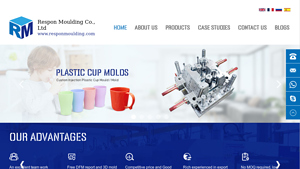Plastic Molding China Guide: Type, Cost, Top List…
Introduction: Navigating the Global Market for plastic molding china
In today’s competitive landscape, international B2B buyers face the challenge of sourcing high-quality plastic molding from China while navigating complex market dynamics. Whether you are looking to manufacture custom components or entire products, understanding the intricacies of the plastic molding industry is crucial for successful procurement. This guide aims to demystify the process by offering insights into various types of plastic molding techniques, their applications across different sectors, and effective supplier vetting strategies.
From low-volume production to high-precision molding, we cover a range of options available to meet diverse business needs. Additionally, we delve into cost considerations, timelines for delivery, and quality assurance practices that can help mitigate risks associated with overseas manufacturing. By equipping you with actionable insights and expert knowledge, this guide empowers buyers from Africa, South America, the Middle East, and Europe—such as Germany and Saudi Arabia—to make informed purchasing decisions.
Navigating the global market for plastic molding in China doesn’t have to be daunting. With the right information, you can optimize your sourcing strategy, ensuring that your products not only meet your specifications but also uphold the quality standards necessary for success in your market.
Understanding plastic molding china Types and Variations
| Type Name | Key Distinguishing Features | Primary B2B Applications | Brief Pros & Cons for Buyers |
|---|---|---|---|
| Injection Molding | High precision, mass production capabilities | Automotive, Electronics, Medical | Pros: High efficiency, cost-effective for large runs. Cons: High initial tooling costs. |
| Blow Molding | Forms hollow objects, ideal for large containers | Packaging, Bottles, Tanks | Pros: Suitable for lightweight products. Cons: Limited to hollow shapes. |
| Compression Molding | Uses heat and pressure to mold thermosetting plastics | Automotive, Electrical Components | Pros: Good for high-strength materials. Cons: Slower cycle times compared to injection molding. |
| Rotational Molding | Creates large, hollow items with uniform thickness | Toys, Tanks, Outdoor Equipment | Pros: Excellent for large parts, low tooling costs. Cons: Longer production times. |
| Thermoforming | Uses heat to form plastic sheets into shapes | Packaging, Automotive, Medical Devices | Pros: Versatile and cost-effective for low volumes. Cons: Less precision than injection molding. |
What are the Characteristics and Suitability of Injection Molding?
Injection molding is one of the most widely used plastic molding techniques, renowned for its ability to produce high-precision parts in large volumes. This method involves injecting molten plastic into a mold, allowing for complex shapes and designs. It is particularly suitable for industries such as automotive and electronics, where consistency and quality are paramount. When considering injection molding, B2B buyers should evaluate the initial tooling costs against the long-term production savings, especially for high-volume projects.
How Does Blow Molding Differ from Other Molding Types?
Blow molding specializes in creating hollow plastic products, such as bottles and containers, by inflating hot plastic inside a mold. This technique is essential for packaging industries where lightweight and durable containers are required. Buyers must consider the limitations of blow molding regarding shape and size, as it is primarily suited for hollow objects. However, its cost-effectiveness for large runs makes it an attractive option for businesses focused on packaging solutions.
What are the Advantages of Compression Molding?
Compression molding is a process that utilizes heat and pressure to shape thermosetting plastics, making it ideal for producing strong and durable parts. Common applications include automotive components and electrical parts. This method is advantageous for industries that require high-strength materials. However, B2B buyers should be aware that compression molding typically has slower cycle times compared to injection molding, which may impact production schedules for high-demand products.
In What Situations is Rotational Molding Preferred?
Rotational molding is an excellent choice for producing large, hollow items like tanks and playground equipment. This technique involves rotating a mold filled with plastic, allowing for even distribution and uniform thickness. While it offers lower tooling costs and is suitable for large parts, buyers should consider the longer production times involved. This method is particularly beneficial for businesses needing durable, lightweight products at a reasonable cost.
Why Choose Thermoforming for Low-Volume Production?
Thermoforming involves heating plastic sheets until pliable and then forming them into specific shapes using molds. This method is versatile and cost-effective, especially for low-volume runs, making it ideal for prototypes or niche products in packaging and medical devices. While it allows for rapid production, buyers must weigh its lower precision against the benefits of speed and flexibility. Understanding the specific needs of their projects will help businesses decide if thermoforming is the right choice.
Key Industrial Applications of plastic molding china
| Industry/Sector | Specific Application of plastic molding china | Value/Benefit for the Business | Key Sourcing Considerations for this Application |
|---|---|---|---|
| Automotive | Production of interior and exterior components | Cost-effective, high precision, and scalability | Quality control, material options, and compliance standards |
| Medical | Manufacturing of medical devices and components | High quality, safety compliance, and reliability | Certifications, material biocompatibility, and lead times |
| Electronics | Creating housings and components for devices | Enhanced durability and design flexibility | Customization options, rapid prototyping, and delivery timelines |
| Packaging | Development of food-safe packaging solutions | Compliance with safety regulations and sustainability | Material certifications, production capacity, and cost-effectiveness |
| Industrial Equipment | Parts for machinery and tooling | Increased efficiency and reduced downtime | Precision engineering, after-sales support, and logistics capabilities |
How is Plastic Molding Used in the Automotive Sector?
In the automotive industry, plastic molding from China plays a pivotal role in producing both interior and exterior components, such as dashboards, bumpers, and trim pieces. The ability to create complex shapes with high precision allows manufacturers to reduce weight and enhance fuel efficiency. For international buyers, key considerations include ensuring compliance with safety and environmental regulations, as well as the need for rigorous quality control processes to minimize defects.
What are the Applications in the Medical Field?
The medical sector relies heavily on plastic molding for the manufacturing of devices and components, including surgical instruments, housings for diagnostic equipment, and packaging for medical supplies. The stringent safety and quality standards require that materials used are biocompatible and that the manufacturing process meets various certifications. Buyers must prioritize suppliers who can demonstrate compliance with international standards, ensuring reliability in critical applications.
How Does Plastic Molding Benefit the Electronics Industry?
In electronics, plastic molding is utilized for creating durable housings and intricate components for devices such as smartphones, computers, and home appliances. The flexibility of design allows for innovative product features while maintaining durability. International buyers should focus on suppliers that offer rapid prototyping services to accelerate product development, as well as those with a track record of delivering on time to meet market demands.
What Role Does Plastic Molding Play in Packaging?
The packaging industry benefits from plastic molding through the creation of food-safe packaging solutions that comply with health regulations. This method allows for mass production of lightweight, sustainable packaging options that protect products during transport. Buyers from various regions should consider the supplier’s ability to provide materials that meet local regulations and their capacity for large-scale production to ensure consistent supply.
How is Plastic Molding Used in Industrial Equipment Manufacturing?
Plastic molding is essential in the production of parts for industrial machinery and tooling, where high precision and durability are crucial. Components such as gears, housings, and fixtures can be produced efficiently, enhancing operational effectiveness. When sourcing, businesses should evaluate the supplier’s engineering capabilities and after-sales support to ensure long-term reliability and performance of the components.
3 Common User Pain Points for ‘plastic molding china’ & Their Solutions
Scenario 1: Navigating Quality Assurance Challenges in Plastic Molding
The Problem: B2B buyers often face significant hurdles when it comes to ensuring the quality of plastic molded products sourced from China. With varying standards and practices across manufacturers, buyers may receive products that do not meet their specifications or, worse, have defects that lead to costly production delays and customer dissatisfaction. This quality inconsistency can stem from inadequate quality control processes, lack of transparency in manufacturing practices, or miscommunication regarding specifications.
The Solution: To mitigate quality assurance challenges, buyers should prioritize establishing robust communication channels with their chosen manufacturers. Before finalizing a supplier, it’s crucial to conduct thorough due diligence by requesting certifications (such as ISO 9001) and visiting the manufacturing facility, if possible. Additionally, implementing a clear and detailed product specification document is essential. This document should outline materials, tolerances, and quality expectations. Regular quality audits and inspections during the production process can further ensure that the products meet the required standards before shipment. Buyers may also consider engaging third-party quality inspection services to provide an unbiased evaluation of the products prior to delivery.
Scenario 2: Overcoming Communication Barriers in International Sourcing
The Problem: Language and cultural differences can create significant communication barriers for international B2B buyers working with Chinese manufacturers. Misunderstandings regarding product specifications, timelines, and payment terms can lead to project delays, increased costs, and strained relationships. For buyers from regions such as Africa and South America, where English may not be the first language, these challenges can be even more pronounced.
The Solution: To address communication issues, buyers should engage with manufacturers who have dedicated English-speaking representatives or those who provide bilingual support. Establishing a clear line of communication from the outset can help mitigate misunderstandings. Utilizing visual aids, such as diagrams or prototypes, can also be beneficial when conveying complex ideas. Additionally, leveraging technology, such as project management and collaboration tools, can enhance transparency and facilitate real-time updates on production status. Regular video calls can foster stronger relationships and ensure that both parties are aligned on project expectations.
Scenario 3: Managing Lead Times and Delivery Expectations
The Problem: One of the most pressing concerns for B2B buyers in the plastic molding sector is managing lead times and delivery expectations. Long production cycles and shipping delays can disrupt supply chains, causing delays in product launches or inventory shortages. Buyers may find it challenging to accurately forecast delivery times, especially when dealing with multiple suppliers or when unforeseen issues arise during the manufacturing process.
The Solution: To effectively manage lead times, buyers should establish clear timelines with their manufacturers from the outset. This involves setting realistic production schedules that account for potential delays, such as material shortages or manufacturing bottlenecks. It’s also advisable to maintain open lines of communication throughout the production process to receive timely updates on any changes. Buyers can enhance their supply chain resilience by diversifying their supplier base, which allows them to switch suppliers in case of delays. Additionally, implementing a just-in-time inventory system can help mitigate the impact of any delays by reducing dependency on large stockpiles of inventory and ensuring that products are only ordered when needed.
Strategic Material Selection Guide for plastic molding china
What Are the Key Properties of Common Materials Used in Plastic Molding in China?
In the realm of plastic molding, selecting the right material is crucial for ensuring product performance and longevity. Below, we analyze four common materials used in plastic molding in China, focusing on their properties, advantages, disadvantages, and considerations for international B2B buyers.
1. Acrylonitrile Butadiene Styrene (ABS)
Key Properties:
ABS is renowned for its excellent impact resistance and toughness, making it suitable for applications requiring durability. It has a temperature resistance of around 80°C and exhibits good chemical resistance against a variety of acids and bases.
Pros & Cons:
The primary advantage of ABS is its strength and flexibility, which allows for the production of robust parts. However, it can be more expensive than other materials, and its manufacturing complexity can increase with intricate designs.
Impact on Application:
ABS is often used in consumer goods, automotive components, and electronic housings due to its ability to withstand mechanical stress and temperature fluctuations.
Considerations for International Buyers:
Buyers from regions like Europe and the Middle East should ensure compliance with standards such as ASTM D3965 and DIN EN 71 for safety and environmental impact.
2. Polypropylene (PP)
Key Properties:
Polypropylene boasts a high melting point (up to 160°C) and excellent chemical resistance, making it ideal for applications involving exposure to solvents and acids.
Pros & Cons:
Its lightweight nature and low cost make PP a popular choice for mass production. However, it has lower impact resistance than ABS and can be prone to warping under high temperatures.
Impact on Application:
PP is widely used in packaging, automotive parts, and household items. Its chemical resistance makes it suitable for containers and medical applications.
Considerations for International Buyers:
Buyers should be aware of compliance with international standards such as ISO 1873 for plastics and ASTM D638 for tensile properties, particularly in regulated markets like Europe.
3. Polyethylene Terephthalate (PET)
Key Properties:
PET is recognized for its excellent clarity, strength, and thermal stability. It can withstand temperatures up to 120°C and is highly resistant to moisture and chemicals.
Pros & Cons:
The clarity and strength of PET make it ideal for packaging applications, especially in the food and beverage sector. However, its higher cost compared to other plastics and the complexity of recycling can be drawbacks.
Impact on Application:
PET is predominantly used in beverage bottles, food containers, and textile fibers. Its moisture barrier properties are crucial for maintaining product integrity.
Considerations for International Buyers:
Compliance with food safety standards, such as FDA regulations in the U.S. and EU directives in Europe, is essential for buyers in the food and beverage industry.
4. Polycarbonate (PC)
Key Properties:
Polycarbonate is known for its high impact resistance and transparency, with the ability to withstand temperatures ranging from -40°C to 120°C.
Pros & Cons:
The durability and optical clarity of PC make it suitable for applications like safety glasses and electronic components. However, its susceptibility to scratching and higher cost can be limitations.
Impact on Application:
PC is commonly used in applications requiring transparency and toughness, such as eyewear lenses, safety equipment, and automotive components.
Considerations for International Buyers:
Buyers should ensure compliance with safety standards such as ANSI Z87.1 for eyewear and ISO 20471 for high-visibility clothing, particularly in markets with stringent safety regulations.
Summary Table of Material Selection for Plastic Molding in China
| Material | Typical Use Case for plastic molding china | Key Advantage | Key Disadvantage/Limitation | Relative Cost (Low/Med/High) |
|---|---|---|---|---|
| ABS | Consumer goods, automotive components | Excellent impact resistance | Higher cost and complexity | Medium |
| Polypropylene (PP) | Packaging, automotive parts | Lightweight and low cost | Lower impact resistance | Low |
| Polyethylene Terephthalate (PET) | Beverage bottles, food containers | High clarity and moisture resistance | Higher cost and recycling complexity | Medium |
| Polycarbonate (PC) | Safety glasses, electronic components | High impact resistance and clarity | Susceptible to scratching | High |
This strategic material selection guide provides B2B buyers with essential insights into the properties and applications of common plastics used in molding processes in China, ensuring informed decision-making for their manufacturing needs.
In-depth Look: Manufacturing Processes and Quality Assurance for plastic molding china
What Are the Main Stages of Manufacturing Processes in Plastic Molding in China?
The manufacturing process for plastic molding in China typically involves several critical stages, each designed to ensure the highest quality and efficiency in production.
Material Preparation: How Are Raw Materials Processed?
The first step in the plastic molding process is the preparation of raw materials. Plastic granules, often made from materials like ABS, PVC, or polycarbonate, are sourced from reputable suppliers. These materials are then dried to remove moisture, which is essential for achieving optimal molding conditions. Proper drying helps to prevent defects such as bubbles or weak spots in the final product.
Forming: What Techniques Are Commonly Used?
Once the materials are prepared, the next stage is forming, primarily through injection molding. In this process, heated plastic is injected into a mold at high pressure. The choice of injection molding technique—such as single-shot or multi-shot molding—depends on the complexity of the part being produced. Advanced techniques like gas-assisted injection molding or insert molding may also be employed for specific applications, allowing for lighter parts and enhanced structural integrity.
Assembly: How Are Components Brought Together?
After the molding process, components may require assembly. This can involve additional processes such as ultrasonic welding or adhesive bonding. Manufacturers in China often provide one-stop solutions, meaning they can handle everything from design to final assembly. This integrated approach not only streamlines production but also reduces costs and lead times, making it particularly advantageous for international buyers.
Finishing: What Post-Molding Processes Are Necessary?
The finishing stage includes surface treatments such as painting, coating, or polishing to enhance the aesthetic and functional properties of the molded parts. Techniques like electroplating or texturing can also be applied depending on the product specifications. This stage is crucial for meeting customer expectations regarding appearance and performance.
What Quality Assurance Measures Are In Place for Plastic Molding?
Quality assurance (QA) is a vital aspect of the plastic molding process in China, ensuring that products meet international standards and client specifications.
What International Standards Are Relevant to Quality Control?
Manufacturers in China often adhere to international quality standards such as ISO 9001, which provides a framework for consistent quality management systems. Additionally, industry-specific certifications like CE for European markets and API for the oil and gas sector may apply, depending on the product’s end use. These certifications indicate a commitment to quality and safety, crucial for B2B buyers looking to mitigate risks associated with sourcing.
What Are the Key QC Checkpoints During Production?
Quality control checkpoints are strategically placed throughout the manufacturing process to ensure that standards are met at every stage. These include:
-
Incoming Quality Control (IQC): This step involves inspecting raw materials before they enter the production line. Any materials that do not meet specifications are rejected, minimizing defects in the final product.
-
In-Process Quality Control (IPQC): During production, samples are taken to assess whether the molding process is proceeding correctly. This ongoing monitoring helps to identify any deviations from quality standards in real time.
-
Final Quality Control (FQC): After production, the finished products undergo thorough testing and inspection to ensure they meet all specifications before shipment. This includes dimensional checks, functional tests, and visual inspections.
What Common Testing Methods Are Used in Quality Assurance?
Common testing methods include:
-
Dimensional Inspection: Using calipers and gauges to ensure that parts meet precise measurements.
-
Mechanical Testing: Evaluating the strength and durability of materials through tensile tests or impact resistance tests.
-
Visual Inspection: A thorough examination of the surface finish and overall appearance of the product.
These testing methods are essential for verifying the integrity and functionality of the molded components.
How Can B2B Buyers Verify Supplier Quality Control?
For international B2B buyers, especially those from Africa, South America, the Middle East, and Europe, verifying a supplier’s quality control processes is paramount. Here are several strategies:
What Steps Can Buyers Take to Conduct Supplier Audits?
Conducting supplier audits is one of the most effective ways to assess quality assurance capabilities. Buyers should request to visit the manufacturing facilities to evaluate the production processes, quality control measures, and overall operational standards. This firsthand observation can provide valuable insights into the supplier’s commitment to quality.
How Can Buyers Request and Analyze Quality Reports?
Buyers should also request detailed quality reports that outline the results of various tests and inspections conducted throughout the production process. Analyzing these reports helps buyers understand how the supplier addresses defects and implements corrective actions.
What Role Do Third-Party Inspections Play in Quality Assurance?
Engaging third-party inspection services can provide an additional layer of assurance. These independent agencies can conduct thorough inspections and testing of products before shipment, ensuring compliance with required standards. This is particularly valuable for buyers who may not have the resources to perform extensive quality checks themselves.
What Nuances Should International Buyers Consider Regarding Quality Control?
When sourcing from China, international buyers must be aware of specific nuances related to quality control. For instance, understanding local manufacturing practices, potential language barriers, and cultural differences in business operations can significantly impact the quality assurance process. Establishing clear communication channels and setting explicit quality expectations upfront can help mitigate these challenges.
In conclusion, the manufacturing processes and quality assurance measures in plastic molding in China are designed to meet the demands of international B2B buyers. By understanding these processes and implementing thorough verification strategies, buyers can ensure they source high-quality products that meet their specifications and standards.
Practical Sourcing Guide: A Step-by-Step Checklist for ‘plastic molding china’
When considering the procurement of plastic molding services from China, it’s essential to follow a systematic approach. This checklist is designed to guide international B2B buyers through the critical steps necessary to ensure a successful sourcing experience. By adhering to these steps, you can mitigate risks and find the right supplier for your needs.
Step 1: Define Your Technical Specifications
Clearly outlining your product requirements is the foundation of a successful sourcing process. This includes dimensions, materials, tolerances, and any specific features your product must have. Providing detailed specifications helps suppliers give accurate quotes and timelines, reducing the likelihood of misunderstandings later in the process.
- Consider prototypes: If possible, develop a prototype to illustrate your requirements more clearly.
- Identify material types: Specify the type of plastic and any certifications required, particularly for industries like medical or automotive.
Step 2: Research and Shortlist Potential Suppliers
Start by researching potential suppliers through online directories, trade shows, and industry referrals. Shortlist those that specialize in your specific requirements and have a solid reputation in the market.
- Check online reviews and testimonials: Look for feedback from other buyers to gauge supplier reliability.
- Evaluate their experience: Prioritize suppliers who have experience in your industry and a proven track record.
Step 3: Evaluate Potential Suppliers
Before making any commitments, conduct thorough evaluations of your shortlisted suppliers. Request detailed company profiles, case studies, and references from other clients in similar industries or regions.
- Assess quality control measures: Inquire about their quality assurance processes and certifications, such as ISO 9001.
- Review production capabilities: Ensure they have the necessary equipment and technology to meet your demands.
Step 4: Request and Compare Quotes
Once you have identified a few potential suppliers, request detailed quotes that include pricing, lead times, and payment terms. Ensure that the quotes are based on the same specifications for an accurate comparison.
- Look for transparency: Suppliers should clearly outline all costs, including tooling, shipping, and any additional fees.
- Consider value over price: While lower prices are attractive, consider the overall value, including quality, service, and delivery times.
Step 5: Verify Supplier Certifications
It is crucial to verify that your chosen supplier holds the necessary certifications relevant to your industry. This ensures compliance with quality standards and regulations.
- Request copies of certifications: Such as ISO, CE, or FDA approvals, depending on your product requirements.
- Check for industry affiliations: Membership in relevant industry associations can indicate a commitment to quality and best practices.
Step 6: Conduct an On-Site Visit or Virtual Tour
If feasible, conduct an on-site visit to the supplier’s facility or request a virtual tour. This step allows you to assess their production capabilities, quality control processes, and overall working environment.
- Meet the team: Engaging with key personnel can help build trust and facilitate better communication.
- Inspect equipment and processes: Ensure they have modern machinery and adhere to industry best practices.
Step 7: Establish Clear Communication Channels
Effective communication is vital throughout the sourcing process. Establish clear channels and protocols for ongoing discussions regarding production updates, issue resolution, and feedback.
- Set expectations early: Discuss preferred methods of communication and response times.
- Use project management tools: Consider utilizing tools that facilitate collaboration and tracking project milestones.
Following this structured approach will empower you to navigate the complexities of sourcing plastic molding services from China effectively, ensuring that you choose a supplier that meets your quality and production needs.
Comprehensive Cost and Pricing Analysis for plastic molding china Sourcing
What Are the Key Cost Components for Plastic Molding in China?
Understanding the cost structure of plastic molding in China is vital for international B2B buyers. The primary cost components include:
-
Materials: The choice of plastic resin significantly impacts costs. Common materials like ABS, PP, and PS are generally more affordable, while specialized materials may incur higher costs. Buyers should consider not just the price of the raw materials but also their availability and lead time.
-
Labor: China’s labor costs remain competitive compared to many Western countries. However, the cost can vary based on the region and the complexity of the manufacturing process. Skilled labor is crucial for high-quality outcomes, especially for complex molds.
-
Manufacturing Overhead: This includes costs related to facilities, utilities, equipment maintenance, and administrative expenses. Efficient production processes can help mitigate these overhead costs, making it essential for buyers to assess a supplier’s operational efficiency.
-
Tooling: Tooling costs can be significant, especially for custom molds. The complexity and size of the mold will affect the price. Buyers should be aware that investing in high-quality tooling can lead to lower production costs in the long run.
-
Quality Control (QC): Implementing strict QC measures is essential to ensure product quality. While this can add to costs, it ultimately reduces the risk of defects and returns, which is especially critical for international transactions.
-
Logistics: Shipping costs can fluctuate based on the shipping method, distance, and current fuel prices. Understanding Incoterms is crucial as they define who bears the shipping costs and risks at various stages of the supply chain.
-
Margin: Suppliers will typically include a profit margin in their pricing. This margin can vary widely based on supplier reputation, service quality, and market conditions.
How Do Price Influencers Affect Plastic Molding Costs?
Several factors influence the final pricing for plastic molding services:
-
Volume/MOQ: Larger order quantities often lead to lower per-unit costs due to economies of scale. Buyers should negotiate minimum order quantities (MOQ) to maximize cost efficiency.
-
Specifications and Customization: Custom designs require additional resources for tooling and production, leading to increased costs. Buyers should clearly communicate their specifications to avoid unexpected expenses.
-
Materials and Quality Certifications: The choice of materials and the required quality certifications can significantly affect costs. Higher quality standards may necessitate more rigorous testing and compliance, which can lead to higher prices.
-
Supplier Factors: The supplier’s reputation, experience, and production capabilities can influence pricing. Established suppliers may charge a premium for their reliability and quality assurance.
-
Incoterms: The agreed-upon Incoterms can also impact pricing. For example, choosing DDP (Delivered Duty Paid) may include higher upfront costs but can simplify logistics for the buyer.
What Tips Can Help Buyers Optimize Costs in Plastic Molding?
For international B2B buyers, particularly from Africa, South America, the Middle East, and Europe, the following tips can help optimize costs:
-
Negotiate Effectively: Establish a strong relationship with suppliers and negotiate terms that can lead to cost savings. Discuss bulk orders, long-term partnerships, or bundled services for better pricing.
-
Consider Total Cost of Ownership (TCO): Evaluate not just the initial purchase price but also the long-term costs associated with quality, maintenance, and logistics. A lower initial price may lead to higher long-term costs if quality issues arise.
-
Research Pricing Nuances: Each region may have different pricing standards and expectations. Familiarize yourself with local market conditions, customs, and regulations to better navigate negotiations.
-
Request Multiple Quotes: Don’t settle for the first quote. Request multiple quotes to compare pricing and services, ensuring you get the best value for your investment.
-
Stay Updated on Market Trends: Being aware of changes in the global plastic market, such as fluctuations in material costs or shifts in labor rates, can provide leverage in negotiations and help forecast budget needs.
Conclusion
While this analysis provides a comprehensive overview of the cost structure and pricing influencers for plastic molding in China, it is crucial to note that prices can vary widely based on specific project details. Engaging with suppliers and conducting thorough market research will ensure a more accurate understanding of potential costs.
Alternatives Analysis: Comparing plastic molding china With Other Solutions
Exploring Alternative Solutions to Plastic Molding in China
When considering manufacturing options for plastic components, businesses often look beyond traditional methods to find the most efficient and cost-effective solutions. This section explores various alternatives to plastic molding in China, comparing them in terms of performance, cost, ease of implementation, maintenance, and best use cases. Understanding these alternatives can help B2B buyers make informed decisions tailored to their specific needs.
| Comparison Aspect | Plastic Molding China | 3D Printing | Thermoforming |
|---|---|---|---|
| Performance | High precision, suitable for complex shapes | Good for prototypes, limited in production speed | Moderate precision, effective for large parts |
| Cost | Generally lower due to economies of scale | Higher per unit cost, but reduced setup costs | Lower for large batches, higher for small runs |
| Ease of Implementation | Requires detailed design and tooling | Quick setup, easy to modify designs | Moderate complexity, depends on part size |
| Maintenance | Minimal, mostly related to machinery | Low, limited to printer upkeep | Moderate, requires mold maintenance |
| Best Use Case | Mass production of intricate parts | Prototyping and small batches | Large, flat parts like packaging |
In-Depth Look at Alternatives
3D Printing
3D printing, or additive manufacturing, has gained traction for its ability to create complex geometries without the need for extensive tooling. This method is particularly advantageous for prototyping, as it allows for rapid iteration and modification of designs. However, the per-unit cost can be significantly higher than traditional molding methods, making it less suitable for mass production. Additionally, while 3D printing is excellent for small batches, its speed and material limitations may hinder scalability for larger projects.
Thermoforming
Thermoforming involves heating plastic sheets until pliable and then forming them into shapes using molds. This method is particularly effective for producing large, flat parts, such as packaging or automotive components. Thermoforming can be more cost-effective than injection molding for larger runs, but it typically lacks the precision required for intricate designs. The setup process is moderately complex and requires careful planning, particularly in mold creation. While maintenance is generally manageable, the molds can wear over time and require periodic replacement.
Conclusion: Choosing the Right Solution for Your Needs
Selecting the appropriate manufacturing solution depends heavily on your specific project requirements, including production volume, design complexity, and budget constraints. For B2B buyers, understanding the strengths and weaknesses of each method is crucial. Plastic molding in China stands out for its cost-efficiency and ability to produce high-quality, intricate components at scale. However, for projects requiring rapid prototyping or larger flat parts, exploring alternatives like 3D printing or thermoforming may yield better results. Ultimately, thorough analysis and alignment with business objectives will guide buyers toward the most suitable manufacturing approach.
Essential Technical Properties and Trade Terminology for plastic molding china
What Are the Key Technical Properties in Plastic Molding?
Understanding the essential technical properties of plastic molding is crucial for B2B buyers looking to source high-quality products from China. Here are some critical specifications:
1. Material Grade
Material grade refers to the specific type of plastic used in the molding process, which can significantly impact the performance and durability of the final product. Common materials include ABS, Polycarbonate (PC), and Polypropylene (PP). Each material has unique properties like impact resistance, heat tolerance, and flexibility, making it vital for buyers to select the appropriate grade for their applications.
2. Tolerance
Tolerance defines the allowable deviation from specified dimensions in a molded part. It is expressed in millimeters or microns and is essential for ensuring that components fit together correctly in assembly. Tight tolerances may be necessary for precision applications, such as in the automotive or medical sectors, where even minor deviations can lead to functional failures.
3. Surface Finish
Surface finish describes the texture and appearance of the molded part’s surface. Options range from smooth to textured finishes, which can affect both aesthetics and functionality. A high-quality surface finish can enhance the visual appeal of a product and also improve its resistance to wear and tear, making it a critical consideration for branding and longevity.
4. Cycle Time
Cycle time refers to the total time taken to produce a molded part, including cooling and ejection time. Shorter cycle times can lead to increased productivity and reduced manufacturing costs, making this a vital metric for buyers concerned about lead times and overall project timelines.
5. Shrinkage Rate
Shrinkage rate is the percentage reduction in size a material undergoes as it cools and solidifies in the mold. It varies by material and affects the final dimensions of the product. Understanding shrinkage rates is essential for accurate molding and helps in maintaining tight tolerances, especially in high-volume production.
What Common Trade Terms Should B2B Buyers Know?
Navigating the landscape of plastic molding requires familiarity with specific industry jargon. Here are key terms that international buyers should understand:
1. OEM (Original Equipment Manufacturer)
OEM refers to a company that produces parts or equipment that may be marketed by another manufacturer. In the context of plastic molding, OEMs provide customized parts tailored to the specifications of a client’s product line, enabling businesses to maintain brand identity while outsourcing production.
2. MOQ (Minimum Order Quantity)
MOQ is the smallest quantity of a product that a supplier is willing to manufacture or sell. Understanding MOQ is crucial for buyers as it affects inventory costs and production planning. Smaller businesses or startups may find it challenging to meet high MOQs, making it essential to negotiate favorable terms.
3. RFQ (Request for Quotation)
An RFQ is a document used by buyers to request pricing and terms from suppliers. It typically includes specifications for the products, quantities needed, and delivery timelines. A well-prepared RFQ can facilitate better negotiation outcomes and ensure that buyers receive accurate quotes tailored to their needs.
4. Incoterms (International Commercial Terms)
Incoterms are a set of predefined commercial terms used in international trade to clarify the responsibilities of buyers and sellers. Understanding these terms is essential for managing logistics, including shipping costs, insurance, and risk transfer. Common terms include FOB (Free on Board) and CIF (Cost, Insurance, and Freight).
5. T1 and T2
T1 and T2 often refer to the first and second tier of suppliers within a supply chain. T1 suppliers provide direct components to manufacturers, while T2 suppliers provide parts or materials to T1 suppliers. This classification is vital for understanding the supply chain dynamics and ensuring quality control at every level.
By grasping these essential technical properties and trade terms, B2B buyers can make informed decisions, ensuring that their plastic molding projects are executed efficiently and effectively.
Navigating Market Dynamics and Sourcing Trends in the plastic molding china Sector
What Are the Current Market Dynamics and Key Trends in the Plastic Molding Sector in China?
The global plastic molding market is witnessing a significant transformation driven by various factors, including technological advancements, rising demand from emerging economies, and the need for cost-effective manufacturing solutions. In particular, the plastic molding sector in China is positioned as a key player due to its competitive pricing, robust manufacturing capabilities, and vast experience in producing high-quality molded components. As international B2B buyers from Africa, South America, the Middle East, and Europe (notably Germany and Saudi Arabia) seek reliable suppliers, understanding these dynamics is critical.
One of the most notable trends is the increasing adoption of automation and Industry 4.0 technologies in manufacturing processes. This shift is enhancing productivity and quality control while reducing lead times. Additionally, the rise of custom and low-volume production is catering to niche markets, allowing businesses to launch products with shorter timeframes. Companies are also leveraging digital platforms for seamless communication and order processing, which is particularly valuable for international transactions.
Furthermore, the demand for sustainable practices is reshaping sourcing strategies. Buyers are increasingly seeking suppliers that prioritize eco-friendly materials and processes. This growing emphasis on sustainability is not only a response to regulatory pressures but also aligns with the values of modern consumers who favor environmentally responsible products.
How Is Sustainability and Ethical Sourcing Influencing B2B Plastic Molding Purchases?
Sustainability has become a cornerstone of modern manufacturing, especially in the plastic molding sector. The environmental impact of plastic production has raised concerns among consumers and businesses alike, prompting a shift towards sustainable practices in sourcing. For B2B buyers, understanding the environmental footprint of their suppliers is essential for maintaining brand integrity and meeting corporate social responsibility goals.
One significant aspect of sustainable sourcing is the use of ‘green’ certifications and materials. Suppliers in China are increasingly offering eco-friendly alternatives, such as biodegradable plastics and recycled materials, which help reduce the overall environmental impact. Certifications like ISO 14001 for environmental management systems are becoming crucial indicators of a supplier’s commitment to sustainability.
Moreover, ethical supply chains are gaining importance. B2B buyers are encouraged to evaluate suppliers based on their labor practices and adherence to ethical standards. This approach not only mitigates risks associated with labor exploitation but also enhances brand reputation, particularly in markets like Europe where consumers are more discerning about ethical practices.
What Is the Brief History of the Plastic Molding Industry in China?
The plastic molding industry in China has evolved significantly over the past few decades. Initially, the sector focused on low-cost production to meet the demands of domestic markets. However, with the advent of globalization in the 1990s, Chinese manufacturers began to expand their capabilities, integrating advanced technologies and improving quality standards.
By the early 2000s, China emerged as a global manufacturing hub for plastic products, attracting international buyers seeking cost-effective solutions. The combination of a skilled workforce, investment in modern machinery, and a focus on quality led to an increase in the production of high-precision plastic components. Today, China is recognized for its innovative approaches to injection molding, catering to various industries, including automotive, electronics, and consumer goods, thus solidifying its position as a leader in the global plastic molding market.
Frequently Asked Questions (FAQs) for B2B Buyers of plastic molding china
-
How do I select the right plastic molding supplier in China?
Selecting the right supplier involves evaluating several key factors. Start by researching the supplier’s experience and expertise in your specific industry. Look for certifications such as ISO 9001, which indicate a commitment to quality management. Request samples to assess the quality of their work, and check for customer reviews or case studies. Communication is vital; ensure they are responsive and can provide support in your preferred language. Lastly, consider their production capabilities, lead times, and whether they can handle your required volume efficiently. -
What are the common minimum order quantities (MOQs) for plastic molding in China?
MOQs for plastic molding can vary significantly based on the complexity of the design and the supplier’s policies. Generally, MOQs can range from 100 to 1,000 units for standard products. However, some suppliers may accommodate lower MOQs for prototyping or custom projects. It’s essential to communicate your needs upfront and negotiate terms that align with your production goals. Always confirm the MOQ in writing to avoid misunderstandings later in the process. -
What payment terms should I expect when sourcing plastic molds from China?
Payment terms can vary, but common practices include a 30% deposit upfront and the remaining 70% upon completion or before shipment. Some suppliers may offer more flexible terms based on your relationship and order size. It’s advisable to use secure payment methods such as letters of credit or PayPal to mitigate risks. Ensure you clarify payment terms in the contract to protect both parties and avoid potential disputes. -
How can I ensure quality assurance in my plastic molding orders?
To ensure quality, request a detailed quality assurance (QA) plan from your supplier. This should outline inspection processes, testing methods, and acceptable defect rates. Consider conducting pre-production meetings to align expectations and standards. You may also hire third-party inspection services to conduct random checks during production. Establishing clear communication channels for feedback and revisions is critical in maintaining quality throughout the manufacturing process. -
What should I know about the logistics of importing plastic molded parts from China?
Logistics is a crucial aspect of international trade. Understand the shipping options available, including air freight for speed and sea freight for cost-effectiveness. Familiarize yourself with customs regulations in your country to avoid delays. Work with a freight forwarder who can navigate the complexities of international shipping and ensure all documentation is in order. Additionally, consider delivery times when planning your inventory to ensure you meet market demands. -
What are the advantages of sourcing plastic molds from China?
Sourcing from China offers several advantages, including competitive pricing due to lower labor costs and economies of scale. Chinese suppliers often have advanced manufacturing technologies and extensive experience in injection molding, which can lead to high-quality products. Additionally, the vast network of suppliers means you can find specialized manufacturers for unique projects. However, it’s vital to conduct thorough research and vet suppliers to mitigate risks associated with quality and communication. -
How do I communicate my design specifications effectively to a Chinese supplier?
To communicate effectively, provide detailed design specifications using clear visuals such as CAD drawings and 3D models. Include dimensions, tolerances, and material types to avoid ambiguity. Utilize a bilingual project manager or translator if necessary to bridge any language gaps. Regular updates and feedback loops throughout the design and production phases will help ensure that your specifications are understood and implemented correctly. -
What are the key considerations for customizing plastic molded products?
Customization can significantly enhance your product’s market appeal. Key considerations include material selection, mold design, and production processes. Discuss your specific needs with the supplier to explore options for color, texture, and functionality. Be aware that customization may increase costs and lead times, so factor this into your project timeline. Request prototypes to evaluate the design and functionality before mass production to ensure the final product meets your expectations.
Important Disclaimer & Terms of Use
⚠️ Important Disclaimer
The information provided in this guide, including content regarding manufacturers, technical specifications, and market analysis, is for informational and educational purposes only. It does not constitute professional procurement advice, financial advice, or legal advice.
While we have made every effort to ensure the accuracy and timeliness of the information, we are not responsible for any errors, omissions, or outdated information. Market conditions, company details, and technical standards are subject to change.
B2B buyers must conduct their own independent and thorough due diligence before making any purchasing decisions. This includes contacting suppliers directly, verifying certifications, requesting samples, and seeking professional consultation. The risk of relying on any information in this guide is borne solely by the reader.
Top 9 Plastic Molding China Manufacturers & Suppliers List
1. Plastopia – Comprehensive Molding Solutions
Domain: plastopialtd.com
Registered: 2015 (10 years)
Introduction: Plastopia offers a variety of molding services including:
– Plastics Injection Molding
– Micro Injection Molding
– Silicone Molding
– Blow Molding
– Extrusion Molding
– Vacuum Forming
– Metal Zinc Die Casting
– CNC Machining
– Custom Metal Parts
Value-added services include:
– 3D Printing Service
– Product Design
Texture Cards & Books:
– Plastopia™ VDI 3400 Texture Card (VDI #12~45…
2. Summit Plastic Molding – Custom Injection Molding Solutions
Domain: summitplasticmolding.com
Registered: 1999 (26 years)
Introduction: Custom Injection Molding from 85 to 1000 ton. Specializes in prototyping and production injection molding for the automotive, medical, and defense sectors. Full-service injection molding supplier with engineering, tooling, and manufacturing capabilities. IATF Certified facilities in Shelby Twp, Michigan and El Paso, Texas; joint venture in Shen Zhen, China for low-cost tooling.
3. Ecomolding – Precision Plastic Injection Molding
Domain: ecomolding.com
Registered: 2014 (11 years)
Introduction: Ecomolding specializes in high-precision plastic injection molded components and assemblies. They offer a range of services including plastic injection molding, injection mold design, and custom mold making. Their factory spans over 2000 square meters and employs over 100 staff, with a production capacity of 40-50 plastic injection molds per month. They focus on various applications including auto…
4. ACE – Plastic Injection Molding Solutions
Domain: ace-mold.com
Registered: 2020 (5 years)
Introduction: ACE is a professional mold and molding manufacturing factory with over 25 years of experience and more than 3000 successful projects. They offer a one-stop solution for plastic injection molding, including services such as mould design, mould making, and various types of injection molding. Key services include:
– Plastic Injection Moulding
– Aerospace Plastic Injection Parts
– Automotive Plasti…
5. Upmold – Plastic Injection Molds
Domain: upmold.com
Registered: 2016 (9 years)
Introduction: Upmold specializes in plastic injection mold making and die casting mold manufacturing. Key products include: 1. Plastic Injection Molds 2. Die Casting Molds 3. Tooling Design Services 4. Injection Molding Services 5. Plastic Parts Production 6. Over Molding 7. Double Injection Molds 8. Gas Assisted Molds 9. Hot Runner Molds 10. Multi-Cavity Molds 11. Insert Molds 12. Unscrewing Molds 13. MUD Rapi…
6. Seaskymedical – Injection Molding Solutions
Domain: seaskymedical.com
Registered: 2021 (4 years)
Introduction: Top 15 China Injection Molding Companies – Seaskymedical Capabilities: Material Selection, LSR Medical Silicone Injection Molding, PP Injection Molding Services, ABS Plastic Injection Molding, TPR Injection Molding, Nylon (Polyamide) Injection Molding, TPE Injection Molding, TPU Injection Molding, PETG/PET Injection Molding, Custom Plastic Molding Service, Product Development, Free Mold Design, Mo…
7. HanKing Mould – Plastic Injection Moulds
Domain: hanking-mould.com
Registered: 2010 (15 years)
Introduction: HanKing Mould is a professional plastic injection mould manufacturer based in China, offering a wide range of services and products including: 1. Plastic Injection Moulds 2. Micro Injection Mold 3. Precision Mould 4. Automotive Mold 5. Electronics Mould 6. 2K Mould 7. Home Appliance Mould 8. Multi Cavity Mould 9. Industrial Mould 10. Insert Molding 11. Medical Mould 12. Prototype Mould 13. Custom …
8. Qmolding – Plastic Injection Molding Solutions
Domain: qmolding.com
Registered: 2019 (6 years)
Introduction: Qmolding offers a range of plastic injection molding services including: 1. Plastic Injection Molding – Utilizes plastic resin pellets melted and formed into specific shapes. 2. Liquid Silicone Rubber (LSR) Molding – Preferred for rubber parts production. 3. Overmolding – Combines two materials in one product. 4. Insert Molding – Injects melted material into pre-made custom inserts. 5. Plastic Mol…
9. Respon Moulding – Rapid Tooling & Injection Molding Services
Domain: responmoulding.com
Registered: 2019 (6 years)
Introduction: This company, Respon Moulding – Rapid Tooling & Injection Molding Services, is a notable entity in the market. For specific product details, it is recommended to visit their website directly.
Strategic Sourcing Conclusion and Outlook for plastic molding china
In today’s competitive landscape, strategic sourcing in plastic molding from China presents unparalleled opportunities for international B2B buyers. Companies can leverage China’s cost-effective manufacturing capabilities, advanced technology, and extensive experience in injection molding to drive efficiency and reduce production costs. By partnering with reputable manufacturers, buyers can ensure high-quality products tailored to their specific needs, whether in automotive, medical, or consumer goods sectors.
Understanding the intricacies of the sourcing process is crucial. From prototyping to final production, maintaining clear communication and setting quality benchmarks can mitigate risks and enhance outcomes. As the demand for precision molded parts continues to rise, embracing a strategic approach to sourcing will empower businesses to navigate challenges effectively and capitalize on market trends.
Looking ahead, the plastic molding industry in China is poised for growth, offering innovative solutions to meet evolving market demands. We encourage buyers from Africa, South America, the Middle East, and Europe to explore partnerships with Chinese manufacturers. By doing so, you can not only enhance your supply chain resilience but also position your business for sustained success in a dynamic global market. Start your journey today and unlock the potential of strategic sourcing in plastic molding.
